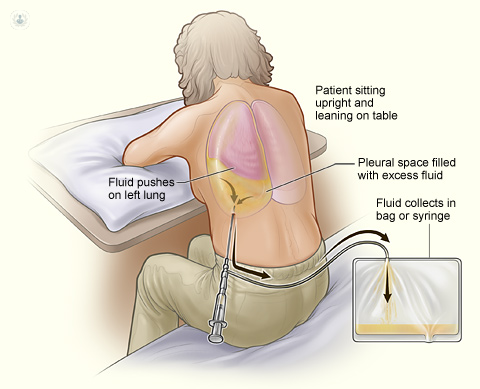

What is thoracentesis?
Thoracentesis is a surgical procedure which uses an image-guided needle to treat pleural effusion, which is an excess of fluids between the lungs and the chest wall.

Why is thoracentesis performed?
Normally, the test is performed in order to relieve pressure in the lungs caused by an excess of pleura, and help improve breathing. The sample obtained can also be used to investigate the cause of pleural effusion.
What happens during thoracentesis?
The procedure begins with a chest X-ray to obtain images of your lungs. You’ll then receive some local anaesthesia in the area of the back where the pleural puncture will take place.
This puncture involves introducing a needle above the rib inside the pleural space to extract a sample of the liquid that will be analysed in the laboratory. After the fluid is removed, the area will be bandaged over.
The whole procedure should take about 15 minutes and you will be able to go home straight away.
Preparing for thoracentesis
To prepare for thoracentesis you may have a blood test to see if your blood is clotting normally.
You’ll need to let the doctor know what medications you are taking, and whether you might be pregnant.
What does the exam feel like?
During the test, you feel an itch when injecting the local anaesthetic and then you can feel pressure or pain in the area when the needle is inserted into the pleural space (space between the chest wall and the tissue that lines the organs of the chest wall).
It is important that the patient does not cough or move during the process as it could cause damage to the lung. If you feel chest pain or difficulty breathing during the procedure, you should tell the specialist.
What do abnormal results mean?
Once the pleural fluid is analysed, if the results are abnormal, this could indicate:
- congestive heart failure (the most common cause of pleural effusion, where the blood doesn’t properly pump blood out of your body)
- pulmonary hypertension
- a chest infection such as pneumonia or tuberculosis
- a blood clot in the lung
- empyema
